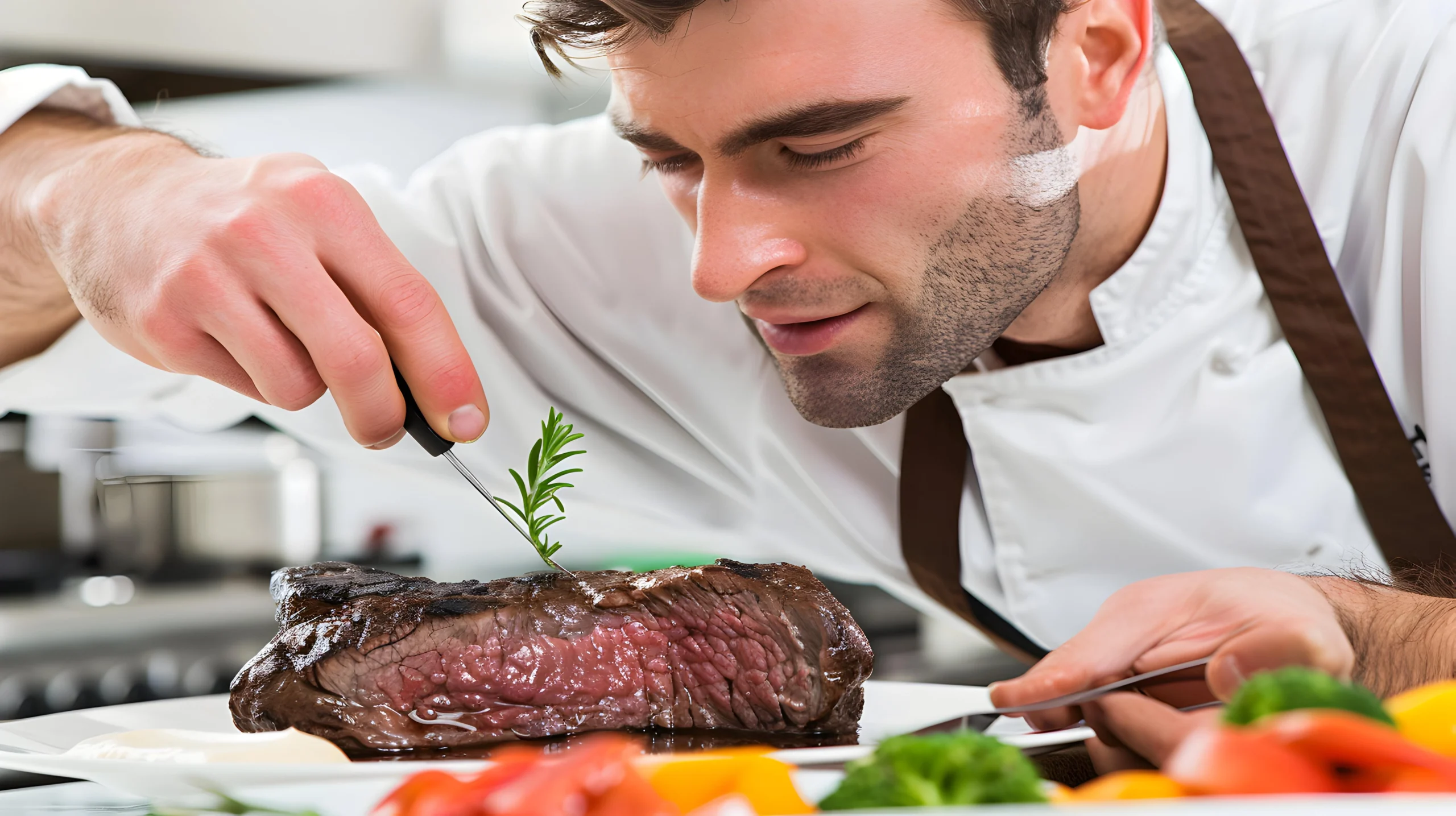There’s nothing quite like a beautifully cooked rib eye roast to impress at the dinner table. With its rich marbling and bold flavor, this cut of beef delivers a melt-in-your-mouth experience when prepared just right. In this recipe, I’ll walk you through a simple yet foolproof method to achieve a perfectly juicy, tender rib eye roast—ideal for a cozy family dinner or a special occasion feast.
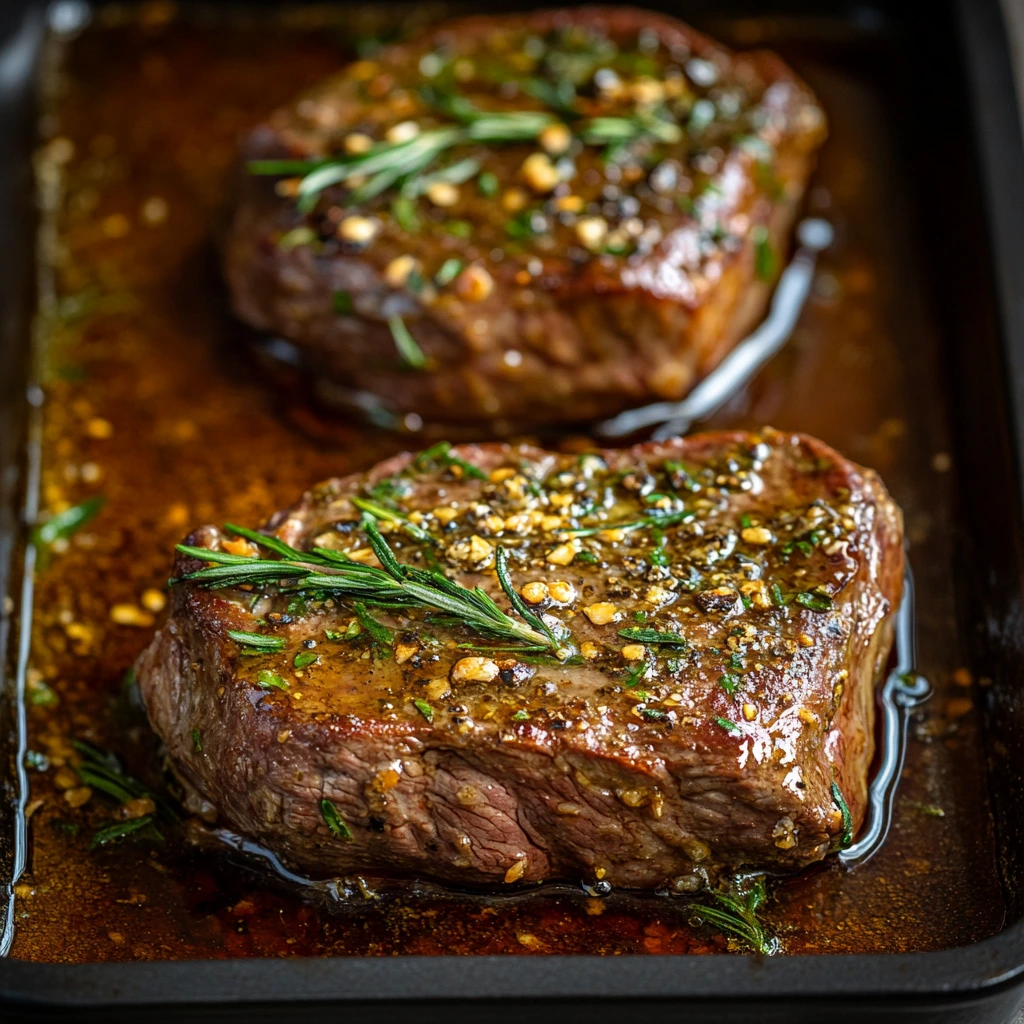
Why Rib Eye Roast Is a Showstopper
A rib eye roast is not just any cut of beef—it’s the star of any dinner table. Here’s why it stands out as a true showstopper:
- Rich Marbling and Flavor
The rib eye roast is renowned for its beautiful marbling—those thin streaks of fat running through the meat. This marbling isn’t just for looks; it’s the key to the roast’s incredible flavor and tenderness. As the roast cooks, the fat melts, infusing the meat with a luscious, rich taste that you simply can’t achieve with leaner cuts. The result? A melt-in-your-mouth experience that makes every bite a delight. - Versatility for Special Occasions
Whether you’re preparing a holiday feast, a Sunday family dinner, or a celebratory meal for friends, the rib eye roast fits the bill perfectly. Its impressive size and beautiful presentation make it a centerpiece that draws attention. Serving a perfectly roasted rib eye lets your guests know they’re in for something special. The whole roast creates an air of elegance, making it the go-to choice for occasions where you want to impress. - Perfect Balance of Tenderness and Juiciness
Unlike tougher cuts of meat, the rib eye roast strikes an ideal balance between tenderness and juiciness. The generous fat content keeps the meat moist throughout the cooking process, so each slice remains juicy and flavorful, even when cooked to higher doneness levels. The texture is tender yet firm enough to slice easily, making it a perfect choice for creating the perfect roast beef experience. - Crust and Caramelization
One of the highlights of cooking a rib eye roast is the delicious crust that forms on the exterior. When roasted at the right temperature, the outside develops a crispy, flavorful caramelized crust that contrasts beautifully with the tender interior. This combination of textures—crispy on the outside, juicy on the inside—makes each bite incredibly satisfying.
In short, a rib eye roast is a meat lover’s dream. Its bold flavor, perfect texture, and impressive presentation make it a true showstopper for any meal. It’s the kind of dish that’s sure to leave a lasting impression on anyone lucky enough to dig in.
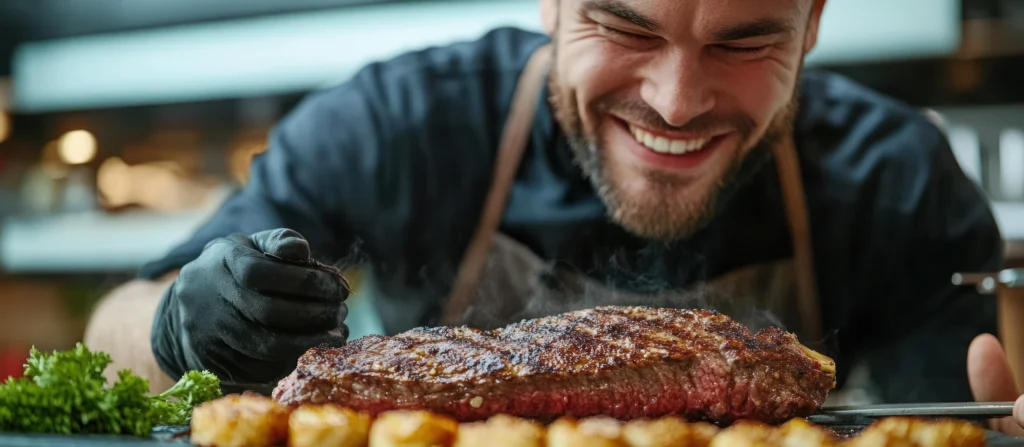
Choosing the Right Rib Eye Roast
When it comes to rib eye roast, selecting the right cut is essential to achieving the perfect result. Here’s how to choose the best rib eye roast for your meal:
- Bone-In vs. Boneless Rib Eye Roast
One of the first decisions you’ll need to make is whether to choose a bone-in or boneless rib eye roast. Both cuts offer great flavor and tenderness, but there are key differences:- Bone-In: The bone helps retain moisture and adds extra flavor during cooking. It also makes for a more dramatic presentation, with the bone giving the roast a “showpiece” look. However, bone-in cuts tend to be harder to carve.
- Boneless: A boneless rib eye roast is easier to carve and serves up neatly, making it ideal for family dinners where everyone wants a perfect slice. While it might lose a bit of that bone flavor, it’s still incredibly juicy and tender.
- Size Matters
The size of your rib eye roast depends on how many people you’re serving. A general rule of thumb is about 1/2 to 3/4 pound of meat per person, which accounts for the shrinkage during cooking. For a small gathering, a 3 to 4-pound roast should suffice, while larger gatherings may require a 6 to 8-pound roast. If you’re cooking for a crowd or want leftovers, don’t hesitate to go bigger! - Look for Even Marbling
Marbling refers to the streaks of fat within the muscle fibers, and it’s crucial for a juicy and flavorful roast. When choosing a rib eye, look for a piece with even marbling throughout the meat. More marbling usually means more flavor and tenderness. Avoid cuts that are too lean, as they may result in a less flavorful roast. - Grade of Meat
Meat is graded based on its quality, and this can significantly affect the taste and texture of your roast. In the U.S., beef is graded as Prime, Choice, or Select:- Prime: The highest grade, offering excellent marbling, tenderness, and flavor. Ideal for a rib eye roast if you want the best of the best.
- Choice: A slightly lower grade, but still very good for roasting. It will have less marbling than Prime, but it can still deliver a tender, juicy roast with proper cooking.
- Select: Less marbled and leaner, which means it could lack some of the richness and tenderness you expect from a rib eye. However, it’s still a decent option if you’re on a budget.
- Fresh vs. Aged Rib Eye Roast
Fresh rib eye roasts are available at most butcher shops and supermarkets, but if you’re looking to take your meal to the next level, you might want to consider an aged rib eye roast. Dry-aging enhances the flavor and tenderness of the beef by allowing it to mature in a controlled environment. While this is typically more expensive, dry-aged rib eye is known for its deep, nutty flavor and melt-in-your-mouth texture. - Where to Buy
When choosing where to buy your rib eye roast, consider your local butcher over a grocery store for the freshest, highest-quality meat. A butcher can provide more insight into the cut of meat, give you advice on size, and may even be able to custom-order a specific cut for you. Many butchers also offer expert advice on cooking methods to ensure the roast turns out perfectly.
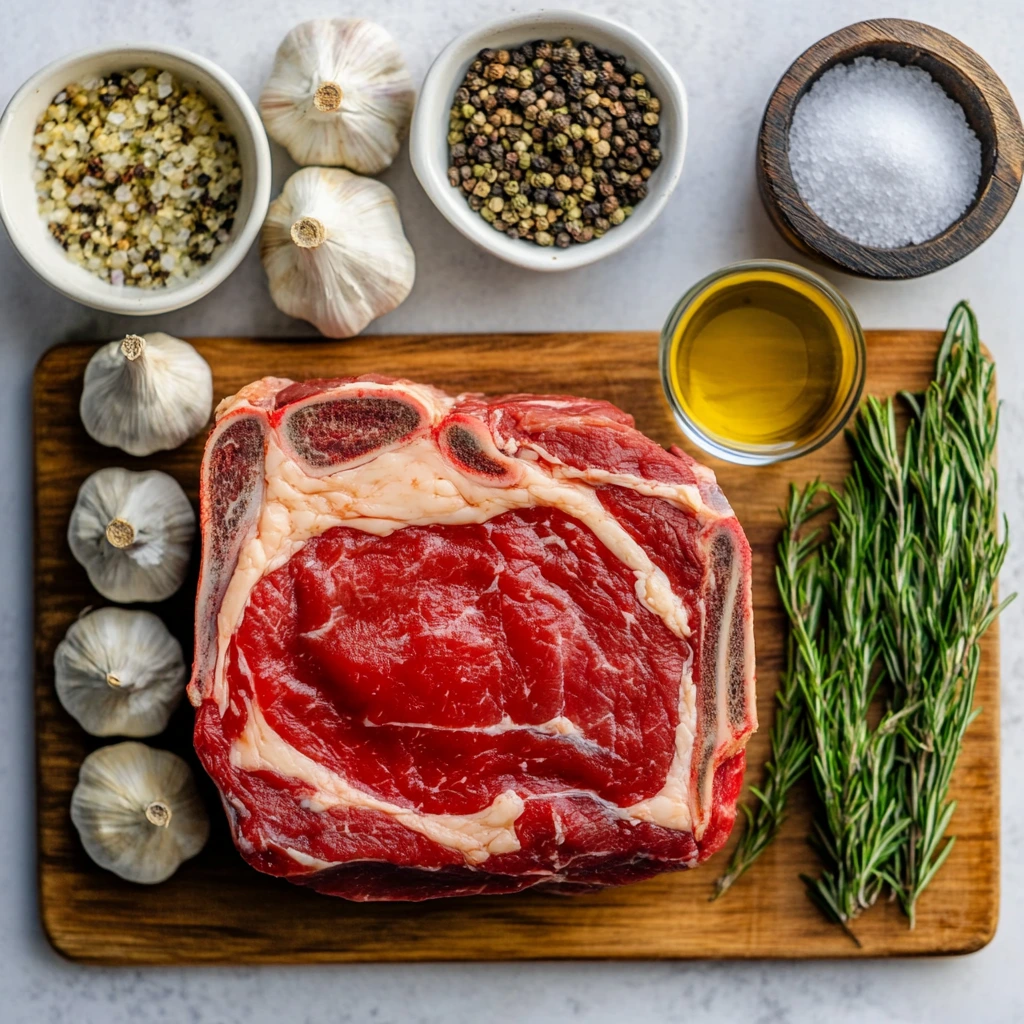
Step-by-Step: How to Cook the Perfect Rib Eye Roast
Cooking a rib eye roast to perfection might sound intimidating, but with the right technique, it’s actually easier than you think. Follow this simple step-by-step guide to achieve a beautifully roasted, tender, and juicy rib eye roast every time.
1. Prepare the Roast
- Bring to Room Temperature: Before you begin cooking, remove the rib eye roast from the fridge and let it sit at room temperature for about 1-2 hours. This helps the roast cook evenly by ensuring that it isn’t too cold in the center when you start roasting.
- Pat Dry: Using paper towels, pat the roast dry to remove excess moisture. This step is key for achieving that golden, crispy crust we all love.
- Season Generously: Liberally season the roast with salt, pepper, and any other spices or herbs you prefer. A classic combination of garlic powder, rosemary, and thyme works wonderfully, but you can experiment with different seasonings to make it your own. Be sure to rub the seasoning into the surface of the meat for maximum flavor.
2. Preheat Your Oven
- Oven Temperature: Preheat your oven to 450°F (232°C). The high heat at the start of cooking is essential for forming a crispy, caramelized crust on the roast. After this initial high-temperature phase, you’ll reduce the heat to ensure the roast cooks evenly throughout.
3. Searing the Roast (Optional, But Recommended)
- Sear in a Hot Pan: For an extra crispy crust, you can sear the roast in a hot skillet before transferring it to the oven. Heat a few tablespoons of oil in a large oven-safe pan over medium-high heat. Once the oil is hot, carefully place the roast in the pan and sear each side for 2-3 minutes, or until a rich brown crust forms. This step isn’t absolutely necessary, but it helps lock in flavor and moisture.
- Transfer to the Oven: After searing, move the roast (with the pan, if using one) into the preheated oven.
4. Roasting the Rib Eye
- Initial High Heat: Roast the rib eye at 450°F (232°C) for the first 15-20 minutes. This blast of heat helps form the perfect crust on the outside of the roast.
- Lower the Temperature: After 15-20 minutes, reduce the oven temperature to 325°F (163°C). Continue roasting for the remainder of the cooking time. The key to a juicy, tender roast is cooking it slowly and at a lower temperature, allowing the fat to render and the meat to tenderize without drying out.
- Cooking Time: The general rule for cooking times is about 15 minutes per pound for medium-rare. However, cooking times can vary depending on the size and shape of your roast, so use a meat thermometer to ensure you reach the desired level of doneness:
- Rare: 120°F (49°C)
- Medium-Rare: 130°F (54°C)
- Medium: 140°F (60°C)
- Medium-Well: 150°F (66°C)
- Well-Done: 160°F (71°C) and above
Insert the meat thermometer into the thickest part of the roast, making sure it doesn’t touch the bone (if using bone-in). This will give you the most accurate reading.
5. Resting the Roast
- Let It Rest: Once the roast reaches your desired temperature, remove it from the oven and transfer it to a cutting board. Cover it loosely with aluminum foil and let it rest for 15-20 minutes. This step is crucial because it allows the juices to redistribute throughout the meat, ensuring each slice is as tender and juicy as possible.
6. Carve and Serve
- Carving the Roast: After the roast has rested, it’s time to carve. Use a sharp carving knife to slice against the grain of the meat. This helps ensure that each slice is tender and easy to chew. Aim for slices about 1/2 inch thick, but feel free to adjust based on your preference.
- Serve: Serve your rib eye roast with your favorite side dishes and enjoy the flavorful, juicy results!
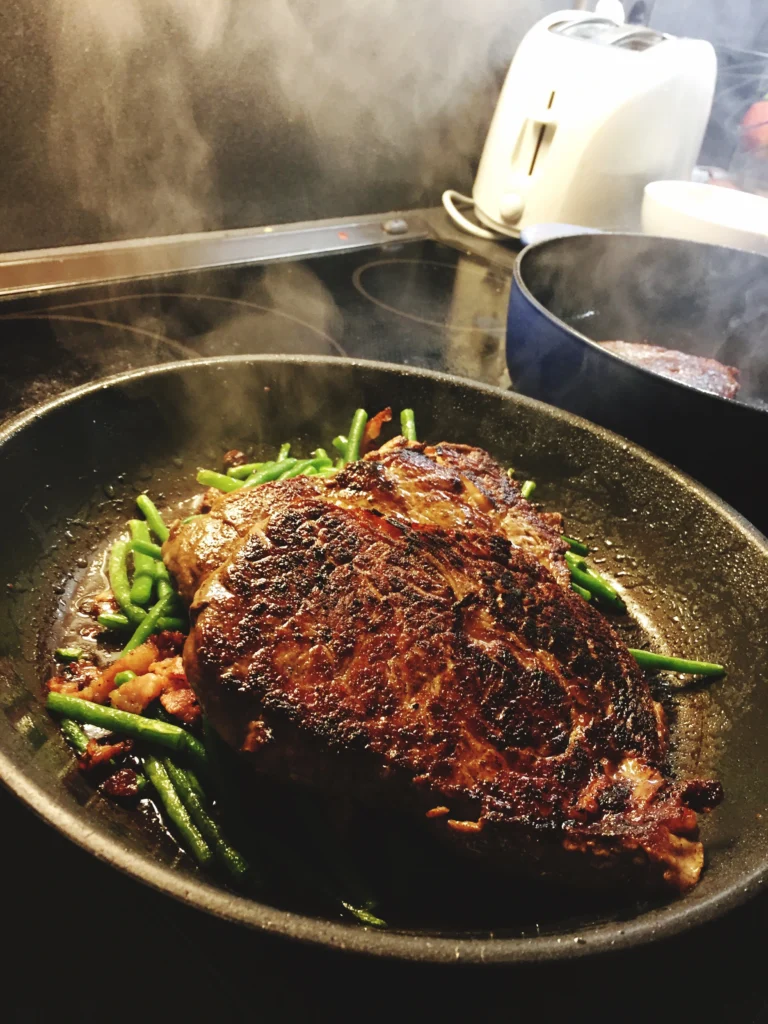
Side Dishes and Pairings That Complete the Meal
A perfectly roasted rib eye is delicious on its own, but the right side dishes and drink pairings can elevate the meal to a whole new level. Here are some classic and creative options to complement your juicy, tender rib eye roast:
1. Classic Side Dishes to Complement the Richness of Rib Eye Roast
- Roasted Vegetables: A medley of roasted root vegetables—such as carrots, parsnips, potatoes, and sweet potatoes—pairs beautifully with the rib eye. The sweetness of the vegetables balances the savory richness of the meat, while the caramelization that occurs during roasting brings out the natural flavors. You can toss them with olive oil, garlic, and fresh herbs like rosemary or thyme before roasting to enhance the flavor.
- Garlic Mashed Potatoes: Creamy, buttery mashed potatoes are a timeless side dish that perfectly complements the rich, tender meat. Add a touch of roasted garlic and fresh cream for extra flavor. The creamy texture of the potatoes contrasts wonderfully with the crispy crust of the rib eye, creating a comforting and indulgent combination.
- Creamed Spinach: Another classic pairing for steak, creamed spinach adds a velvety texture and a rich, earthy flavor that balances the richness of the rib eye. The creaminess pairs well with the tender beef, creating a luxurious side dish that’s sure to be a hit.
2. Creative Side Dishes to Elevate the Meal
- Truffle Mac and Cheese: For a more decadent twist, serve a luxurious truffle mac and cheese as a side dish. The creamy cheese sauce, enhanced by the earthy flavor of truffle oil, pairs beautifully with the meaty richness of the rib eye roast. This indulgent side dish offers a delightful contrast in both texture and flavor.
- Grilled Asparagus with Lemon Zest: Grilled asparagus adds a smoky, charred element to your meal, which complements the savory flavors of the roast. Finish it off with a sprinkle of lemon zest and a drizzle of olive oil for a refreshing, bright contrast to the richness of the meat.
- Roasted Brussels Sprouts with Balsamic Glaze: The slightly bitter flavor of Brussels sprouts works wonders when roasted and drizzled with a balsamic glaze. The sweetness of the glaze enhances the sprouts, while the crispy edges give them a satisfying texture. This dish provides a perfect contrast to the tender beef and offers a nice balance of flavors.
3. Wine Pairings to Enhance the Meal
- Full-Bodied Red Wine: A rib eye roast pairs best with a full-bodied red wine that can stand up to the richness of the meat. Some excellent options include:
- Cabernet Sauvignon: With its bold tannins and dark fruit flavors, Cabernet Sauvignon is a classic pairing for rib eye. Its structure and acidity cut through the fat of the roast, enhancing the flavors of both the meat and the wine.
- Malbec: A Malbec offers ripe fruit flavors with a touch of smokiness, making it a perfect match for the juicy, flavorful rib eye. The soft tannins and bold character of Malbec complement the meat’s richness.
- Syrah/Shiraz: If you prefer something a little spicier, a Syrah or Shiraz is an excellent choice. Its peppery notes and robust flavors pair perfectly with the meaty, savory flavors of the rib eye.
- White Wine Option: If you prefer white wine, go for a Chardonnay with some oak influence. The creaminess and slight nuttiness of the wine can work surprisingly well with a rib eye roast, especially when served with creamy side dishes like mashed potatoes or creamed spinach.
4. Additional Beverage Pairings
- Beer: If you’re a beer drinker, try pairing the rib eye roast with a rich stout or a porter. The roasted malt flavors in these beers enhance the savory qualities of the beef, and the full body complements the richness of the roast.
- Non-Alcoholic Pairings: For those who prefer non-alcoholic beverages, a sparkling apple cider offers a crisp, slightly sweet contrast to the savory beef. The effervescence helps cleanse the palate between bites, making each mouthful feel fresh.
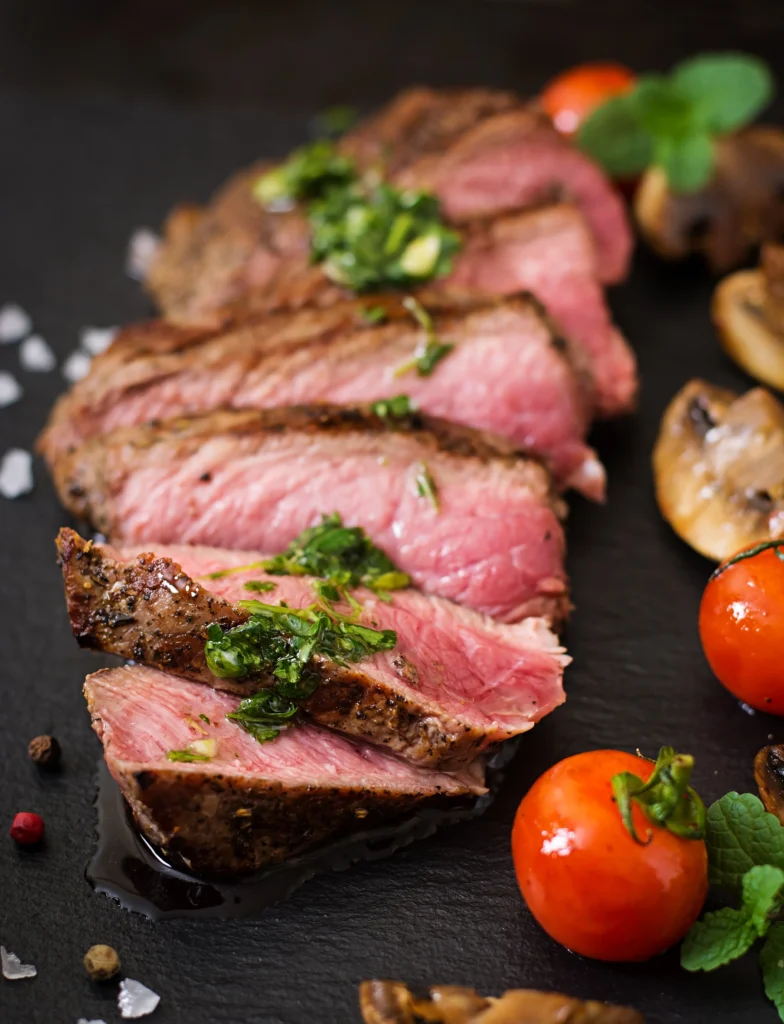
Tips, Variations, and Storage
To help you master the art of rib eye roast cooking, here are some helpful tips, delicious variations to try, and storage suggestions for leftovers:
1. Tips for Cooking the Perfect Rib Eye Roast
- Use a Meat Thermometer: To avoid overcooking or undercooking your rib eye, always use a meat thermometer. It’s the most reliable way to ensure your roast reaches the perfect level of doneness. Don’t rely solely on cooking time—check the internal temperature to guarantee accuracy.
- Avoid Opening the Oven Too Often: Every time you open the oven door, heat escapes, which can affect the roasting time and temperature. Try to resist the urge to peek at the roast during cooking. Instead, trust the timer and use the thermometer to check for doneness.
- Rest the Roast: Don’t skip the resting period after cooking. Letting the roast rest for 15-20 minutes before carving helps redistribute the juices, resulting in a more flavorful and tender roast.
- Use a Roasting Rack: If possible, place your rib eye roast on a roasting rack inside the pan. This allows air to circulate around the meat, promoting even cooking. It also helps prevent the roast from sitting in its own juices, which can cause it to steam rather than roast.
2. Variations to Experiment With
- Herb Crusted Rib Eye Roast: For a flavorful twist, try coating the roast in a herb mixture before cooking. Combine fresh herbs like rosemary, thyme, and parsley with garlic, olive oil, and a touch of Dijon mustard. This will create a fragrant, savory crust that adds depth to the flavor of the roast.
- Coffee and Spice Rub: If you love a bit of bold, smoky flavor, try adding a coffee-based rub to your rib eye roast. Mix ground coffee with spices like brown sugar, smoked paprika, cumin, and chili powder for a unique, savory crust. The coffee adds an earthy depth that complements the richness of the beef.
- Crispy Parmesan Crust: For an extra layer of indulgence, top the roast with grated Parmesan cheese during the final stages of roasting. The cheese will melt into a golden, crispy crust, adding a savory, cheesy flavor that pairs beautifully with the meat.
- Smoked Rib Eye Roast: If you own a smoker, consider smoking your rib eye roast instead of roasting it in the oven. Smoking imparts a deep, smoky flavor that enhances the natural taste of the beef. Be sure to keep the smoker temperature low and slow for the best results.
3. Storing Leftover Rib Eye Roast
- Refrigerating Leftovers: After your meal, allow any leftover rib eye roast to cool down to room temperature (no longer than 2 hours to ensure food safety). Wrap the roast tightly in plastic wrap or aluminum foil and store it in an airtight container in the refrigerator. Leftover rib eye roast will keep for 3-4 days.
- Freezing Leftovers: If you want to keep leftovers for longer, consider freezing them. Slice the roast into smaller portions, wrap each portion tightly in plastic wrap or freezer paper, and place it in a freezer bag. Rib eye roast can be stored in the freezer for up to 3 months. When ready to eat, thaw the roast in the refrigerator overnight and reheat gently in the oven to avoid drying it out.
- Reheating: To reheat, place the slices in a single layer on a baking sheet and cover them with foil. Heat in a preheated oven at 250°F (121°C) until warmed through. This low and slow method ensures that the roast won’t dry out. Alternatively, you can reheat the roast in a skillet over low heat with a bit of beef broth to keep it moist.
- Repurposing Leftovers: Don’t let those delicious leftovers go to waste! Rib eye roast can be used in a variety of dishes:
- Steak Sandwiches: Thinly slice the leftover roast and serve it on a toasted bun with some horseradish sauce and caramelized onions for a hearty sandwich.
- Beef Tacos or Burritos: Shred the leftover roast and use it in tacos or burritos with your favorite toppings like avocado, salsa, and cilantro.
- Beef Salad: Slice the leftover rib eye roast thinly and toss it with mixed greens, roasted vegetables, and a tangy vinaigrette for a delicious steak salad.
Table of Contents
Ribeye Roast Recipe {Quick & Easy} – The Big Man’s World ® (thebigmansworld.com)
Easy Salsa Macha Recipe with Simple Ingredients and Big Flavor – labelrecipes.com

